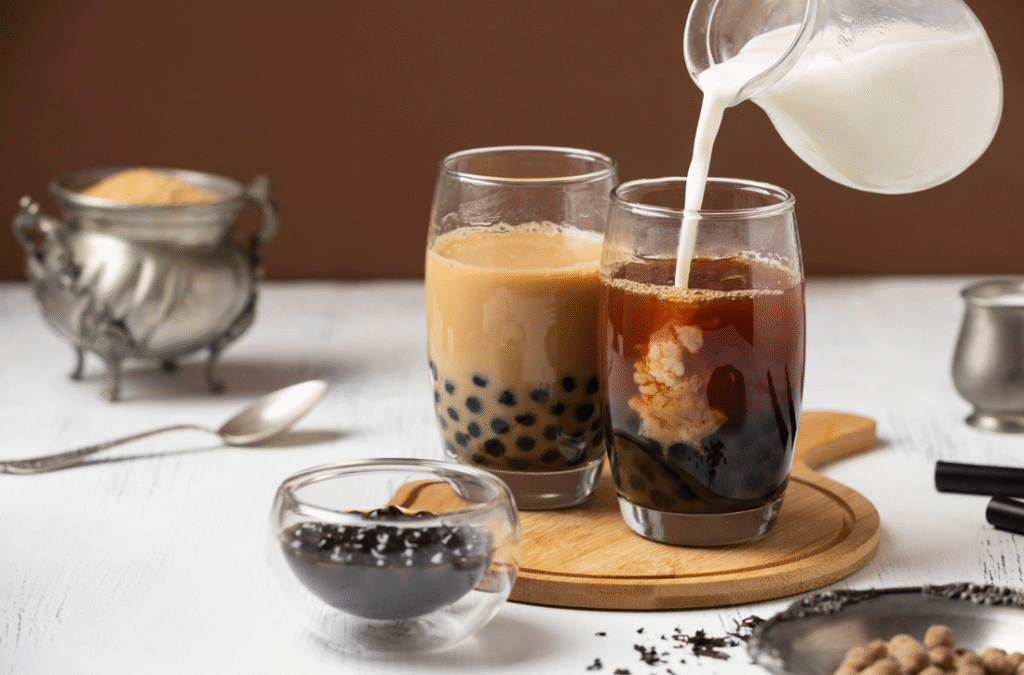You’ve nailed your branding. Your shop is in a prime location. Your social media is buzzing.
But your tea tastes different from Monday to Friday—and customers are noticing.
Scaling a bubble tea business isn’t just about more cups and more staff. It’s about sourcing ingredients that stay consistent when demand spikes.
If you’re planning to grow your bubble tea operations, sourcing from a reliable supplier like bobo tea, a Europe-based wholesale partner who understands scaling, can make all the difference.

Tea Bases and Bubble Tea Ingredients—It Starts with the Right Leaf
Choosing the right tea base is the first—and arguably most important—step. From jasmine green tea to roasted oolong, consistency is everything.
Click here to explore premium bubble tea ingredients from a trusted international supplier offering bulk teas, toppings, and more.
Each tea variety has a distinct flavor profile and brew requirement:
- Green teas offer floral and grassy notes, ideal for fruit-based drinks.
- Black teas like Assam or Ceylon provide bold, malty undertones that pair well with milk-based recipes.
- Oolong sits somewhere in between—fragrant, smooth, and versatile.
When sourcing at scale, it’s not just about taste. You’ll need:
- Bulk quantities with a long shelf life
- Consistent batch quality
- Fast delivery
Whether you’re preparing 100 cups a day or 1,000, reliable tea sourcing sets the foundation for every drink you serve.
Who Should Choose What?
- Fruit-forward menus: High-grade green or jasmine tea.
- Milk-heavy recipes: Robust Assam or Ceylon black tea.
- Multi-location chains: Vacuum-packed teas for consistency.
Common Mistake: Switching tea suppliers frequently to save cost can backfire—slight differences in oxidation or cut can alter flavor. Test in small batches before switching.
Tapioca Pearls, Popping Boba, and Other Chewy Add-ons

When most people think of bubble tea, they picture the iconic black tapioca pearls nestled at the bottom of a clear cup. But the world of toppings has evolved—and if you’re serving a modern audience, especially Gen Z customers, you’ll want to offer variety.
Key Toppings:
- Tapioca pearls (boba): Still a staple, available in various sizes. Pre-cooked or quick-cook variants save time during peak hours.
- Popping boba: Juice-filled spheres in lychee, mango, passion fruit, and blueberry. No cooking required, perfect for fruit teas or self-service bars.
- Nata de coco, grass jelly, fruit jellies: Vegan-friendly texture variety.
Who Should Use What?
- New shops: Ready-to-serve toppings like jelly or popping boba.
- Traditional menus: Always stock tapioca pearls.
- Self-service stations: Colorful options like kiwi or strawberry boba.
Common Mistake: Overstocking perishable toppings. Start with 3–5, monitor popularity, and scale based on real sales—not assumptions.
Quick Tip: 1kg of dry tapioca yields ~3.5kg cooked—good for 25–30 drinks.
Flavored Syrups and Sweeteners—Consistency Is Key
Top-quality tea and toppings mean little if your syrups vary by the day. At scale, syrup consistency is critical to brand trust.
Types of Syrups:
- Fruit syrups (strawberry, lychee, kiwi): Key to fruity drinks. Opt for high-concentration syrups with clear dilution ratios.
- Brown sugar syrup and fructose: Define milk teas. Brown sugar offers depth and caramel tones; fructose sweetens without flavor interference.
Who Should Use What?
- High-volume shops: Bulk syrups with dosing pumps.
- Seasonal menus: Smaller packs to reduce waste.
- Premium shops: Syrups with real fruit extract or clean-label options.
Common Mistake: Mixing brands mid-season—same “mango” flavor can taste different across suppliers. Consistency matters more than savings.
Inventory Tip: Unopened syrups last 6–9 months. Opened? 30 days. Rotate and label carefully.
Milk Powders and Creamers for Signature Recipes
Your milk choice defines both flavor and brand positioning.
- Non-dairy milk powders: Industry standard—long shelf life, easy to store, and stable in hot/cold applications.
- Plant-based creamers (oat, almond, coconut): Appeal to vegan and lactose-free customers, introduce new flavor depth.
Who Should Use What?
- Vegan-forward shops: Oat or coconut milk powders.
- Busy urban shops: Shelf-stable dairy-free creamers with fast mix ratios.
- Premium menus: Blend two types for flavor layering.
Common Mistake: Mixing incompatible milk and syrup profiles. Test before switching suppliers—fruit syrups and plant milks can clash.
Yield Guide: 1kg milk powder = ~8–10L liquid base. Track usage by recipe, not guesswork.
Packaging, Straws, and Branding Touchpoints
Don’t underestimate your packaging—it’s your most visible marketing tool.
Essentials:
- Sealed PET/PP cups with fat straws (standard for hygiene and spill reduction).
- Custom branding: Logos, seasonal art, QR codes for loyalty programs.
- Sustainability options: Compostable straws, paper cups, or reusable jars.
Who Should Prioritize What?
- Delivery-first shops: Leakproof cups, labels with prep timestamps.
- New brands: Invest in design—first impressions matter.
- Eco brands: Use packaging that reflects values and certifications.
Common Mistake: Ordering custom packaging too early. Start with neutral designs, then iterate post-feedback.
Branding ROI: Every 1,000 cups = ~10,000 impressions. That’s free advertising in motion.
Building Operational Efficiency: From Prep to Peak Hours
Great ingredients are only part of the equation—how you prepare, portion, and serve them at scale determines your profit margins and customer satisfaction. That’s why operational efficiency should be part of your sourcing strategy from day one.
Invest in tools that streamline consistency, such as digital tea brewers, automated fructose dispensers, or pre-portioned topping trays. These tools reduce human error, save time, and make it easier to train new staff.
Batch preparation is another key to surviving busy hours. Many top-performing stores use time-based prep schedules, dividing daily workflows into morning, pre-lunch, and late afternoon prep blocks. This minimizes downtime and ensures fresh ingredients are always on hand.
If you’re planning multi-store expansion, creating standard operating procedures (SOPs) for everything—from tea steeping times to syrup ratios—is essential. Clear, repeatable systems are what separate one-shop wonders from scalable brands.
Who Should Prioritize This?
- Stores with more than 80 cups/day capacity
- Brands training new staff monthly
- Owners targeting multi-location growth within 12–18 months
Common Mistake: Relying too heavily on manual processes or “experienced” staff. Systems—not people—should carry your consistency.
Pro Tip: Treat your daily workflow like a production line. The smoother your back bar runs, the faster your bubble tea business grows.
Final Thoughts: Scaling Success Starts with Smart Sourcing
Every successful bubble tea brand shares one thing in common: they’ve built a reliable foundation with the right ingredients. From tea bases and toppings to packaging and consistency, every detail matters when you scale up.
Scaling isn’t just about buying more—it’s about buying smarter. Choose suppliers that support your workflow, fit your equipment, and allow for repeatable quality.
You don’t need an industrial kitchen—just consistency, flexibility, and the right partner.
Bubble Tea Business Launch Checklist
Before placing your first wholesale order, make sure you can answer:
- Do your core recipes match your ingredients and supplier options?
- Can you store, rotate, and label everything properly?
- Will your packaging withstand both in-store and delivery service?
- Have you tested all recipes under actual shop conditions?
Smart sourcing = scalable operations. That’s the real recipe for bubble tea succes






